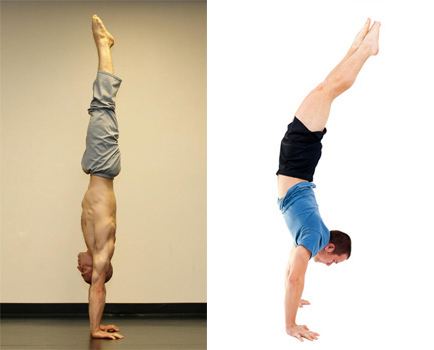Strengthens Shoulder, Arm, Wrist Follow-up poses Janusirsasana | Stretches Navel Pose type Balance, Inversion | |
Note Consult a doctor before beginning an exercise regime Preparatory poses Adho mukha śvānāsana, Bakasana, Uttanasana, Tadasana, Supta Virasana, Virasana, Phalakasana Similar Lotus position, Shavasana, Sirsasana, Bakasana, Vriksasana | ||
Beginner yoga handstands with kino
A handstand is the act of supporting the body in a stable, inverted vertical position by balancing on the hands. In a basic handstand the body is held straight with arms and legs fully extended, with hands spaced approximately shoulder-width apart. There are many variations of handstands, but in all cases a handstand performer must possess adequate balance and upper body strength.
Contents
- Beginner yoga handstands with kino
- Yoga for beginners how to do a yoga handstand safely advanced complete beginners yoga
- Gymnastics
- Breakdance
- Variations
- Risk
- References

Handstands are performed in many athletic activities, including acro dance, cheerleading, circus, yoga, and gymnastics. Some variation of handstand is performed on every gymnastic apparatus, and many tumbling skills pass through a handstand position during their execution. Breakdancers incorporate handstands in freezes and kicks. Armstand dives—a category found in competitive platform diving—are dives that begin with a handstand. In games or contests, swimmers perform underwater handstands with their legs and feet extended above the water.

Handstands are known by various other names. In yoga, the handstand is known as Adho Mukha Vrksasana translating to Downward-facing Tree Pose. In capoeira it is named bananeira.
Yoga for beginners how to do a yoga handstand safely advanced complete beginners yoga
Gymnastics

There are two basic handstand styles in modern gymnastics: curved-back and straight-back. Straight-back style is employed when the aesthetics of straight body lines are desired and feasible. In many cases (e.g., when a handstand is being performed in conjunction with a gymastic apparatus), however, the curved-back style is preferred as it offers superior control over balance. In all cases, balance is maintained by shifting body weight towards the fingers or the heel of the hand.
All basic gymnastic handstands have these characteristics:
In addition, straight-back handstands have these characteristics:
Breakdance
Handstand "freezes" are common in breakdance, in which dancers strive to assume visually interesting body shapes that are not subject to formal rules.
Variations
Common handstand variations include:
Risk
Blood pressure in the head increases to abnormally high levels when the body is inverted. When one is inverted for extended periods, the prolonged high blood pressure may exacerbate preexisting medical conditions and increase the risk of stroke, pulmonary oedema, and other ailments.
